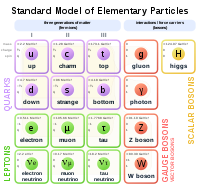
Higgs mechanism

In the Standard Model of particle physics, the Higgs mechanism is essential to explain the generation mechanism of the property 'mass' for gauge bosons. Without the Higgs mechanism, all bosons (one of the two classes of particles, the other being fermions) would be considered massless, but measurements show that the W+, W−, and Z bosons actually have relatively large masses of around 80 GeV/c2. The Higgs field resolves this conundrum. The simplest description of the mechanism adds a quantum field (the Higgs field) that permeates all space to the Standard Model. Below some extremely high temperature, the field causes spontaneous symmetry breaking during interactions. The breaking of symmetry triggers the Higgs mechanism, causing the bosons it interacts with to have mass. In the Standard Model, the phrase 'Higgs mechanism' refers specifically to the generation of masses for the W±, and Z weak gauge bosons through electroweak symmetry breaking. The Large Hadron Collider at CERN announced results consistent with the Higgs particle on 14 March 2013, making it extremely likely that the field, or one like it, exists, and explaining how the Higgs mechanism takes place in nature. In the Standard Model of particle physics, the Higgs mechanism is essential to explain the generation mechanism of the property 'mass' for gauge bosons. Without the Higgs mechanism, all bosons (one of the two classes of particles, the other being fermions) would be considered massless, but measurements show that the W+, W−, and Z bosons actually have relatively large masses of around 80 GeV/c2. The Higgs field resolves this conundrum. The simplest description of the mechanism adds a quantum field (the Higgs field) that permeates all space to the Standard Model. Below some extremely high temperature, the field causes spontaneous symmetry breaking during interactions. The breaking of symmetry triggers the Higgs mechanism, causing the bosons it interacts with to have mass. In the Standard Model, the phrase 'Higgs mechanism' refers specifically to the generation of masses for the W±, and Z weak gauge bosons through electroweak symmetry breaking. The Large Hadron Collider at CERN announced results consistent with the Higgs particle on 14 March 2013, making it extremely likely that the field, or one like it, exists, and explaining how the Higgs mechanism takes place in nature. The mechanism was proposed in 1962 by Philip Warren Anderson, following work in the late 1950s on symmetry breaking in superconductivity and a 1960 paper by Yoichiro Nambu that discussed its application within particle physics. A theory able to finally explain mass generation without 'breaking' gauge theory was published almost simultaneously by three independent groups in 1964: by Robert Brout and François Englert; by Peter Higgs; and by Gerald Guralnik, C. R. Hagen, and Tom Kibble. The Higgs mechanism is therefore also called the Brout-Englert-Higgs mechanism, or Englert-Brout-Higgs-Guralnik-Hagen-Kibble mechanism, Anderson-Higgs mechanism, Anderson-Higgs-Kibble mechanism, Higgs-Kibble mechanism by Abdus Salam and ABEGHHK'tH mechanism On 8 October 2013, following the discovery at CERN's Large Hadron Collider of a new particle that appeared to be the long-sought Higgs boson predicted by the theory, it was announced that Peter Higgs and François Englert had been awarded the 2013 Nobel Prize in Physics. The Higgs mechanism was incorporated into modern particle physics by Steven Weinberg and Abdus Salam, and is an essential part of the standard model. In the standard model, at temperatures high enough that electroweak symmetry is unbroken, all elementary particles are massless. At a critical temperature, the Higgs field becomes tachyonic; the symmetry is spontaneously broken by condensation, and the W and Z bosons acquire masses (also called “electroweak symmetry breaking”, or EWSB.) Fermions, such as the leptons and quarks in the Standard Model, can also acquire mass as a result of their interaction with the Higgs field, but not in the same way as the gauge bosons. In the standard model, the Higgs field is an SU(2) doublet (i.e. the standard representation with two complex components called isospin), which is a scalar under Lorentz transformations. Its electric charge is zero; its weak isospin is 1⁄2; its weak hypercharge (the charge for the U(1) gauge group) is 1 . Under U(1) rotations, it is multiplied by a phase, which thus mixes the real and imaginary parts of the complex spinor into each other, combining to the standard two-component complex representation of the group U(2). The Higgs field, through the interactions specified (summarized, represented, or even simulated) by its potential, induces spontaneous breaking of three out of the four generators ('directions') of the gauge group U(2). This is often written as SU(2) × U(1), (which is strictly speaking only the same on the level of infinitesimal symmetries) because the diagonal phase factor also acts on other fields – quarks in particular. Three out of its four components would ordinarily resolve as Goldstone bosons, if they were not coupled to gauge fields.
